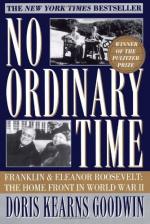|
This section contains 782 words (approx. 2 pages at 400 words per page) |

|
No Ordinary Time Summary & Study Guide Description
No Ordinary Time Summary & Study Guide includes comprehensive information and analysis to help you understand the book. This study guide contains the following sections:
This detailed literature summary also contains Topics for Discussion and a Free Quiz on No Ordinary Time by Doris Kearns Goodwin.
This book is entitled No Ordinary Time: Franklin and Eleanor Roosevelt: The Home Front in World War II. Goodwin's idea was to write a history of World War II, not from a military standpoint, but rather, about what happened here in the United States. It is also a psychohistory about Eleanor and Franklin Roosevelt. Goodwin becomes a psychoanalyst, who delves into their childhood traumas, emotional lives, family relationships, and even their extra-marital affairs, to create an understanding of them as human beings.
The book opens in May 1940, with FDR receiving the terrible news that Hitler's armies had attacked Holland, Luxembourg, Belgium, and France. He was worried that the United States was not prepared for war at all. There were no munitions factories or military draft. Instead, Americans were producing automobiles and washing machines. The Great Depression was not quite over, but the worst had seemed to have passed.
Roosevelt immediately rose to the occasion. He told the American people that just because there were oceans separating them from World War II, it didn't mean they were safe. However, they will remain neutral for the time being. He made a dramatic call for the production of fifty thousand planes a year. He began to nurse along a closer connection between business and government.
Meanwhile in Europe, the British armies miraculously escaped the Germans at Dunkirk. Italy entered the war on the side of Germany. France fell to the Nazis.
As the focus moved from domestic issues to foreign, Eleanor Roosevelt felt lost and abandoned. She had traveled actively as First Lady since 1932 and now the President was ignoring her. She asked to be sent to Europe with the Red Cross. However, it was denied due to the trip being considered too risky.
In 1940, Roosevelt overthrew the two-term tradition and was elected to a third-term. He promised that the United States would become "the arsenal of democracy" and supply free nations with weapons, ships, and airplanes against Germany and Italy. He came up with the ingenious term "Lend-Lease." Speaking in a homey, countrified way, he said a good neighbor lends his friends a fire hose in an emergency and does not ask for money. He secretly met with British Prime Minister Winston Churchill at sea and drew up the Atlantic Charter.
On December 7, 1941, the United States declared war on Germany, Italy, and Japan after Japan's surprise attack on the American naval base at Pearl Harbor. Roosevelt had eleven million men in the armed services and began to call for the production of even more aircraft, tanks, and guns. Coffee, sugar, nylon, rubber, aluminum, and other commodities were rationed.
Churchill, Roosevelt, and Russian Premier Joseph Stalin became known as the "Big Three." They met throughout the war and made all the major decisions about what needed to be done. The conferences at Teheran and Quebec were about setting up a major cross channel invasion, convincing Stalin to help defeat Japan, and setting up the United Nations.
In 1944, Roosevelt won a fourth-term as President of the United States.
Once it was clear Germany would be defeated, the Big Three met in 1945 at Yalta to decide what to do about Germany, Poland, and the United Nations. Stalin walked away from these conferences with most of Eastern Europe.
Eleanor found a niche for herself by working for civil rights, especially for equal treatment of black soldiers. She traveled not only in the United States, but overseas to visit wounded soldiers and battlefields. She worked with the European refugee problem and continued to write her daily newspaper column. She was the first First Lady to address a national political convention and the first to hold a job in government. She and her husband conducted many inspections of war defense plants.
The book covers a lot about their personal lives, which were unusual. Eleanor and Franklin were more like business partners working in politics than man and wife. Eleanor was extremely useful to Roosevelt because she was vocal and liberal, which pleased the left wing of the Democratic Party. She could say things he believed, but could not necessarily act upon politically. Their four sons were in the armed services and their daughter, Anna, served as her father's personal assistant. Many friends and aides lived on and off in the White House, including Harry Hopkins, Lorena Hickok, Princess Martha of the Netherlands, Roosevelt's mother, Missy LeHand, and many guests such as Winston Churchill, who would visit for months at a time.
Roosevelt grew very sick and doctors knew that he had about a year to live when he ran for his fourth-term. He did not live to see victory in Europe or the defeat of Japan.
Read more from the Study Guide
|
This section contains 782 words (approx. 2 pages at 400 words per page) |

|



